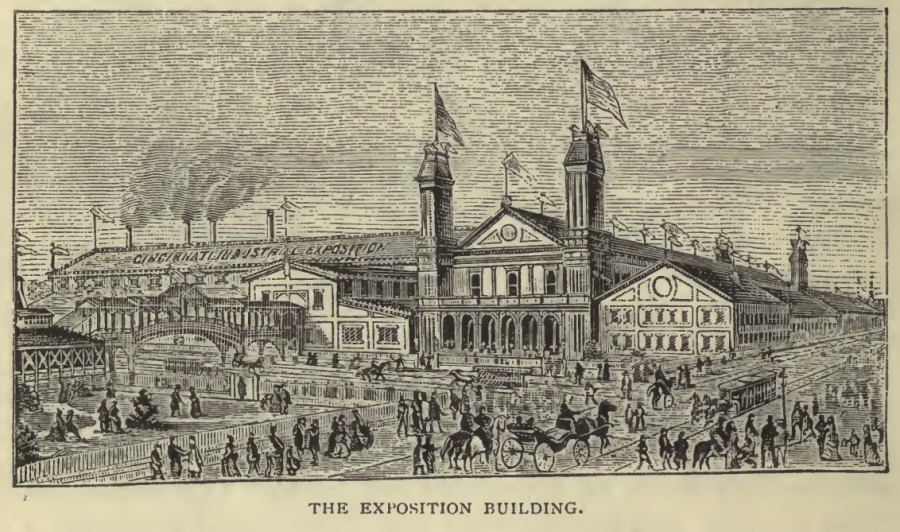Cincinnati has long been known for exceptional haunted houses. As the Cincinnati Commercial noted, as far back as 1875 [29 August]:
“But, nevertheless, we occasionally hear of some uncanny places even in practical, pork-packing Cincinnati, where the dead render the lives of the living a burden to them.”

From Illustrated Cincinnati; a pictorial hand-book of the Queen City, by D.J. Kenny, Robert Clarke and Company, 1875. Digitized by Public Library of Cincinnati & Hamilton County; Image extracted from PDF by Greg Hand
And, Cincinnati has one huge “uncanny place” in our world-famous Music Hall. That grand edifice sits on property once occupied by an immense set of wooden “Exposition Buildings,” which had their own haunted history. According to the Cincinnati Commercial:
“The site occupied by the buildings is none other than the old Potter’s Field, which formerly extended west beyond the bed of the canal, and which was abandoned to other uses about thirty five years ago. When the canal was cut through this soil, enriched with human remains and sown with human bones, about a hundred skeletons had to be removed and committed to the already overcrowded Place of Nameless Graves now covered by the buildings.”
But there was another, more grisly source of human remains in the old Potter’s Field, according to the Commercial.
“When the steamer Moselle, (in 1838, we believe), exploded her boilers above the site of the present Water works, and blew the skulls and limbs and blackened trunks of her passengers all over the city, so that falling bodies fell through the roofs of houses, the remains of the victims were gathered together and buried in a spot now covered by the south end of the Horticultural Hall.”

Illustration from Steamboat Disasters and Railroad Accidents in the United States: To which is Appended Accounts of Recent Shipwrecks, Fires at Sea, Thrilling Incidents, Etc, By Southworth Allen Howland Dorr, Howland & Company, 1840; Image extracted from PDF by Greg Hand
The Moselle, a steamboat built at Cincinnati, was among the largest and fastest boats of her era. On 25 April 1838, the Moselle left Cincinnati for St. Louis with 250 to 300 passengers on board. The boat’s boilers exploded, and everything forward of the paddle wheels shattered into splinters. More than 150 passengers and crew died.
Even in 1875, any excavation at the Exposition Buildings turned up skeletal remains. An elevator shaft sunk in the Power Hall required the removal of more than a barrelful of skulls and bones, which were “placed under the floor in another portion of the building.” The Commercial noted that, in addition to Potter’s Field, the site of the Exposition Buildings was also an orphan asylum and a Civil War military hospital.
“Not a foot of ground lies under the Exposition Building unoccupied by moldering bones – human bones – which the ringed worms have long since tired of gnawing. It was, of course, natural enough that the ghosts disinterred from the bed of the canal, and the ghosts claiming kinship with the bones disinterred to make room for the elevator, should cease to rest.”
The Exposition Buildings weren’t very old in 1875, maybe five years in operation, but the Commercial described the vast wooden structures as dingy, gloomy and grotesque, presaging their demolition in 1876 to make way for the new Music Hall. A night watchman was only too happy to give the Commercial reporter an earful about paranormal mischief:
“The weirdest and strangest noises would occur at intervals all night. Rappings on the ceiling, under the floor, on the doors and windows, the sound of stealthy footfalls behind me, or of loud tramping before me; the crash of heavy timbers thrown from the ceiling, of glass dashed upon the floor, of heavy bodies being dragged over the planking – these never ceased except during Exposition time.”
The watchman reported loud knocking on the front doors one snowy night. When he opened the doors, no one was there and there were no footprints in the freshly fallen snow. He never saw any ghosts, but he felt them frequently:
“They never touch me, but I always know when they are around, by an icy chill, a thrill as of electricity, a feeling like what the French call peau de poulet – goose flesh. They never annoy me now by mere knocking and rapping, for I have got used to it. So used to it that sometimes when people have really knocked at the door I didn’t open, because I thought it was only the dead that kept knocking, knocking, knocking.”
The watchman reported something in the Main Hall that sounded like a man marching and dragging a musket across the wooden floor. A medium witnessed it as well and claimed it was a soldier, perhaps one who died in the military hospital.
The old Exposition buildings were demolished in 1876 to accommodate the new Music Hall. According to architect George Roth, in his essay for the book Cincinnati’s Music Hall [1978]:
“The construction of Music Hall was ‘fast-tracked.’ Before the drawings were off the drafting board, demolition of the old Halle, clearing of the site (which unearthed numerous graves requiring re-interment in Spring Grove Cemetery), and the excavation work was started. This was in October of 1876.”
Although many skeletons were moved to Spring Grove, not all were. Excavations in 1927 uncovered three coffins which were reburied in the basement. Another 1927 expansion uncovered 65 graves, earning that side of Music Hall the nickname of “Valley of Death.” Those remains were also reburied onsite. In May 1988 another elevator shaft uncovered 207 pounds of bones encased in concrete. These bones ended up in an anthropological study at the University of Cincinnati.
The Society for the Preservation of Music Hall has collected some good contemporary ghost stories and you can take a ghost tour of the building.
This article was reposted with permission from Greg Hand, editor of Cincinnati Curiosities





Facebook Comments